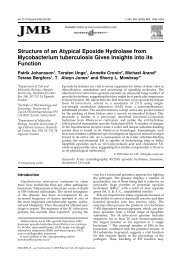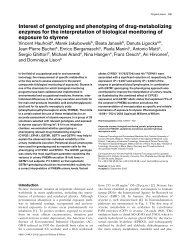comparison, CMR glc was estimated from Patlak plots includingthe data from 15 to 45 min after injection for linear regression.Statistical AnalysisTo compare the 2 methods, that is, 18 F-FDG kinetic modelingwith the shunt IF <strong>and</strong> the IDIF, correlations were calculated forestimates <strong>of</strong> K FDG <strong>and</strong> CMR glc , respectively, each estimated witheither IF type. Bl<strong>and</strong>–Altman plots (20) were generated to furthervisualize the comparison. Correlations <strong>of</strong> the single rate constantsK 1 –k 4 as estimated with either IF type were calculated. The SDs <strong>of</strong>the fit <strong>of</strong> individual rate constants with either counter IF or IDIFwere compared with F tests, <strong>and</strong> the results were corrected formultiple comparisons with the Bonferroni adjustment. Fit parameters<strong>of</strong> the 2 mouse strains were compared with 2-tailed homoscedastict tests. Data are presented as mean 6 SD.RESULTSPlasma glucose levels ranged from normal to high glycemicvalues in C57BL/6 mice (11.8 6 4.1 mmol/L; range,6.7–16.9 mmol/L; n 5 5), whereas CD1 mice showed a widerrange (8.5 6 5.4; range, 1.9–19.2 mmol/L; n 5 10). Excluding2 CD1 mice with extreme values, plasma glucose levelsreached 5.4–13.0 mmol/L in the CD1 mice (n 5 8).IFsFor all animals, the source images corresponding to theestimated independent components separated the lumina <strong>of</strong>the ventricles, that is, the blood pool, from the myocardium,that is, the tissue compartment. Figure 3 shows an example<strong>of</strong> a representative set <strong>of</strong> images. IDIFs were generatedfrom the EL-ICA results as described above. Agreementwith the respective real-time shunt IF was good (Fig. 2);all R 2 obtained with linear correlation <strong>of</strong> the 2 IFs weregreater than 0.89, suggesting no major differences in shape.Differences were present mostly around the peak at theend <strong>of</strong> the infusion, when PET frame lengths were shortest.For comparison, residuals were normalized to injecteddose per gram <strong>of</strong> body weight. The mean <strong>of</strong> the residuals<strong>of</strong> all datasets was not significantly different from zero(0.0087 6 0.227, P . 0.38; Fig. 2B). The IFs are shownFIGURE 4. Kinetic model fits <strong>of</strong> CD1 mouse brain time–activitycurve with respective IFs. (A) Model fit applying shunt IF (R 2 50.999). (B) Model fit <strong>of</strong> same time–activity curve with correspondingIDIF (R 2 5 0.998). Insets show residual differences between modelfit <strong>and</strong> brain time–activity curve.with a logarithmic time scale in Supplemental Figure 3. Acomparison <strong>of</strong> the individual shunt IFs revealed large differences<strong>and</strong> a dependency <strong>of</strong> their shape on plasma glucoselevels, therefore prohibiting the use <strong>of</strong> a populationst<strong>and</strong>ard IF.Compartment Modeling <strong>of</strong> 18 F-FDG Uptake inthe BrainBrain (cerebrum) PET data were fitted with the 18 F-FDG2-tissue-compartment model with both IDIFs <strong>and</strong> shunt IFs(Fig. 4). A typical PET/CT image is shown in SupplementalFigure 1. Excellent fits were obtained in all animals withboth IFs (all R 2 . 0.99 for both mouse strains <strong>and</strong> types <strong>of</strong>IF). The 2 fits <strong>of</strong> a representative dataset are shown inFigure 4. Of the 10 CD1 mice, the 2 animals with thelowest <strong>and</strong> highest plasma glucose concentrations were excludedfrom the following statistical tests because the fitwith the IDIF did not converge to a solution with physiologicK 1 <strong>and</strong> k 2 .The mean value for the K FDG achieved with the shunt IFwas 0.035 6 0.013 mL/cm 3 /min <strong>and</strong> 61 6 11 mmol/min/100 g for CMR glc in C57BL/6 mice, which is higher thanthe 40.6 6 13.3 mmol/min/100 g in the cerebral cortexpublished previously by Yu et al. (16). The respective valuesin CD1 mice were higher (0.057 6 0.019 mL/cm 3 /min<strong>and</strong> 75 6 24 mmol/min/100 g, n 5 8), but the differencesbetween strains were not statistically significant (P . 0.05<strong>and</strong> P . 0.25). Table 1 provides an overview <strong>of</strong> the rateconstants <strong>and</strong> metabolic rates. Good correlations wereobtained for K FDG <strong>and</strong> CMR glc , respectively, comparingtheir estimations with the IDIF <strong>and</strong> shunt IF (Fig. 5).Plotting K FDG values from the fits with shunt IF versusIDIF resulted in a slope <strong>of</strong> 0.932, indicating a tendencytoward estimating higher values when IDIFs are used(Fig. 5A). The slope was 0.902 for CMR glc (Fig. 5B).This discrepancy between the 2 methods is also reflectedby the Bl<strong>and</strong>–Altman plots in Figures 5C (K FDG ) <strong>and</strong> 5D(CMR glc ).Rate constants K 1 , k 2 , <strong>and</strong> k 3 were higher by trend for theIDIF. Correlations comparing the single process rate constantsapplying IDIF <strong>and</strong> shunt IF were moderate for K 1(K 1,shunt 5 0.31 · K 1,IDIF 1 0.17, R 2 5 0.47, <strong>and</strong> K 1,shunt 50.57 · K 1,IDIF 1 0.08, R 2 5 0.38, for CD1 <strong>and</strong> C57BL/6,respectively) <strong>and</strong> significant only for CD1 mice (P , 0.05),for which n was higher (8 vs. 5). No significant correlationwas found for k 2 in either strain. Correlations significantlydifferent from zero were found for k 3 (k 3,shunt 5 0.38 ·k 3,IDIF 1 0.08, R 2 5 0.65, <strong>and</strong> k 3,shunt 5 1.33 · k 3,IDIF 10.07, R 2 5 0.94, for the 2 strains) <strong>and</strong> k 4 (k 4,shunt 5 0.52 ·k 4,IDIF 1 0.02, R 2 5 0.65, <strong>and</strong> k 4,shunt 5 0.89 · k 4,IDIF 10.003, R 2 5 0.69, respectively), with P , 0.05 for CD1 butnot C57BL/6.Patlak AnalysisGraphical analysis yielded CMR glc values <strong>of</strong> 38 6 10<strong>and</strong> 39 6 17 mmol/min/100 g in C57BL/6 mice with theREAL-TIME INPUT FUNCTION IN MICE • Alf et al. 135
TABLE 1Average Rate Constants <strong>and</strong> Metabolic RatesStrain Method K 1 (mL/min/cm 3 ) k 2 (1/min) k 3 (1/min) k 4 (1/min) K FDG (mL/min/cm 3 )CMR glc(mmol/min/100 g)CD1 (n 5 8) Shunt 0.25 6 0.04 0.48 6 0.16 0.13 6 0.03 0.03 6 0.015 0.057 6 0.019 75 6 24IDIF 0.30 6 0.11 0.55 6 0.25 0.23 6 0.14 0.03 6 0.018 0.063 6 0.03 79 6 30C57BL/6 (n 5 5) Shunt 0.27 6 0.09 0.57 6 0.10 0.08 6 0.02 0.018 6 0.004 0.035 6 0.013 61 6 11IDIF 0.33 6 0.10 0.81 6 0.09 0.11 6 0.02 0.025 6 0.004 0.041 6 0.013 73 6 20Values are mean 6 SD.shunt IF <strong>and</strong> IDIF, respectively, <strong>and</strong> 43 6 20 vs. 42 6 18mmol/min/100 g in CD1 mice. These values were significantly(both P , 0.05) lower than those obtained by the2-tissue-compartment model for both strains. No significantdifferences were found between the fit precision obtainedwith either IF type.Influence <strong>of</strong> the Type <strong>of</strong> IF on the Goodness <strong>of</strong> FitTo evaluate the influence <strong>of</strong> the type <strong>of</strong> IF on thegoodness <strong>of</strong> fit <strong>of</strong> the 2-compartment model, the relativeSDs <strong>of</strong> the single fit parameters as revealed by PMOD withthe Levenberg–Marquardt algorithm were compared viaF tests (Table 2). The use <strong>of</strong> the shunt IF resulted in significantlymore precise (smaller SD) fits <strong>of</strong> K 1 <strong>and</strong> k 2 in allanimals, as well as <strong>of</strong> k 3 in most <strong>and</strong> k 4 in some animals.The alternative hypothesis (s 2 shunt IF . s 2 IDIF) had no significantresults for any rate constant in any dataset. TheFIGURE 5. Correlations <strong>and</strong> Bl<strong>and</strong>–Altmann plots for K FDG <strong>and</strong>CMR glc determined with shunt IF <strong>and</strong> IDIF. (A) K FDG <strong>and</strong> (B) CMR glcestimates achieved with either type <strong>of</strong> IF show almost perfect linearcorrelation. (C) <strong>and</strong> (D) Bl<strong>and</strong>–Altmann plots for K FDG <strong>and</strong> CMR glcindicating higher values when determined with IDIF <strong>and</strong> relativelylarge interval <strong>of</strong> 62 SDs, suggesting that at least 1 method is <strong>of</strong>mediocre reliability.model fit residuals (x2 ) were not markedly different forthe 2 methods. F tests, corrected for multiple comparisons,showed a significantly (P , 0.001) smaller fit SD for K FDG<strong>and</strong> CMR glc when the shunt IF was used in all C57BL/6mice <strong>and</strong> 5 <strong>of</strong> the 8 CD1 mice.DISCUSSIONIn this work, we demonstrated that the measurement <strong>of</strong>the input curve with a coincidence counter in mice is feasiblewith practically real-time resolution <strong>and</strong> no blood loss. Themeasurement <strong>of</strong> the blood time–radioactivity curve with theshunt/coincidence counter system resulted in a high precision<strong>of</strong> the kinetic model fit.The question arises as to the gold st<strong>and</strong>ard with which tocompare our measurements. In general, the gold st<strong>and</strong>ardwould be manual blood sampling. However, it is notpossible to obtain a time-resolved IF by manual samplingin mice because <strong>of</strong> the small overall blood volume. Webelieve that the measurement in the shunt has no disadvantagescompared with manual sampling <strong>and</strong> provides a suitablealternative st<strong>and</strong>ard. This was demonstrated in rats,where manual sampling <strong>and</strong> shunt measurements yieldedpractically identical results (15). The shunt features additionalrelevant benefits such as minimal blood loss, real-time temporalinput curve resolution, <strong>and</strong> a practical means for infusion<strong>of</strong> tracer <strong>and</strong> pharmacologic agents. It provides high signallinearity <strong>and</strong> reliability <strong>and</strong> is independent <strong>of</strong> surroundingelectromagnetic fields, in contrast to b-probe systems (6,21),which constitute the only alternative approach currently availablewith a similar temporal resolution yielding full inputcurves. The b-probe approach depends heavily on the positioning<strong>of</strong> the detector <strong>and</strong> suffers from a lower sensitivity.The model values obtained using the IDIF are higher bya 7% <strong>and</strong> 10% mean difference for K FDG <strong>and</strong> CMR glc , respectively,with a relatively high variability in the me<strong>and</strong>ifferences, as seen in the Bl<strong>and</strong>–Altman plots. The nonsystematicdeviations could result from the differences inheight <strong>and</strong> temporal distribution <strong>of</strong> the residuals comparingthe 2 types <strong>of</strong> IF around the peak period. Another likelyexplanation is the lower temporal resolution <strong>of</strong> the IDIF <strong>and</strong>an associated overfitting. Despite these average differences,the estimations correlated strongly between the 2 methodsused. This is in line with previous publications reportingdecent agreement even for input curves with highly incon-136 THE JOURNAL OF NUCLEAR MEDICINE • Vol. 54 • No. 1 • January 2013





